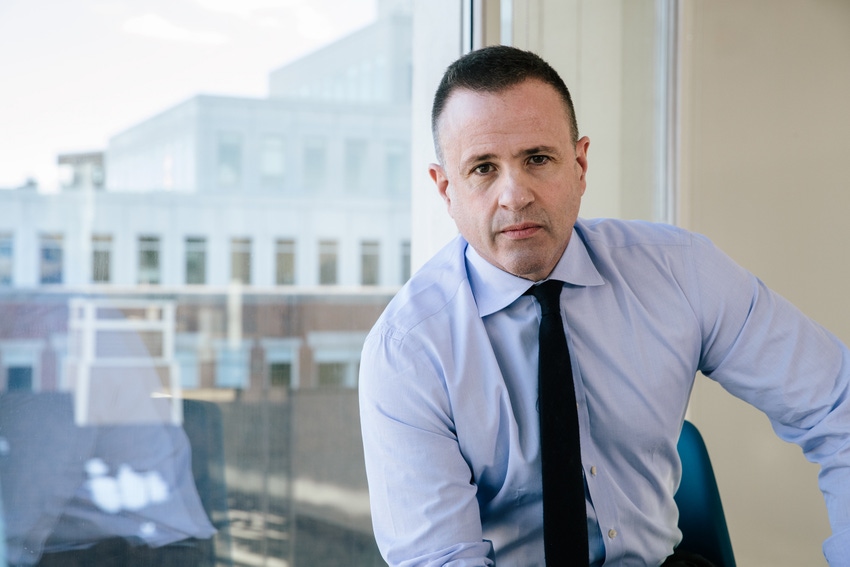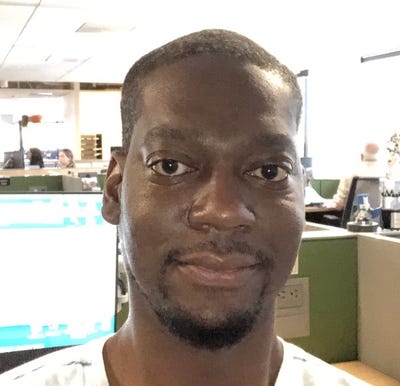From Zero to $5.75 Billion: Velis Talks Building Medtech Powerhouses
Christopher Velis, who is known as the co-founder of Auris Health, shared his journey in healthcare and advice on how to become successful in the medtech industry, during a keynote session at MD&M Minneapolis. Velis also founded Miraki Innovation – a technology investment and development firm that identifies medical breakthroughs and builds those ideas into companies that have substantial investor returns. He serves as executive chairman of the Cambridge, MA-based company.
October 15, 2019

Christopher Velis is known as the co-founder of Auris Health, a surgical robotics company Johnson & Johnson acquired for $3.4 billion with the potential for up $2.35 billion in milestones. Velis has since founded Miraki Innovation–a technology investment and development firm that identifies medical breakthroughs and builds those ideas into companies that have substantial investor returns. He serves as executive chairman of the Cambridge, MA-based company.
Velis shared his journey in healthcare during a keynote session at MD&M Minneapolis Oct. 23 titled, From Zero to $5.75 Billion: Making Medtech Powerhouses. MD+DI caught up with the entrepreneur to talk to him about the session and his career in healthcare.
MD+DI: Let’s talk about your beginnings in medtech. How did you become interested in healthcare and medtech for that matter?
Velis: I started my career at a software company that offered high-end engineering software for companies like Lockheed Martin and NASA then went to business school and shortly thereafter made the move to Wall Street at Merrill Lynch. The world was shifting, and tech was becoming big. My software background helped me tremendously - I had expertise few others had at that time, and it propelled my career forward.
It was while I was on Wall Street that my long-held desire to help people became more pronounced. The medtech category was becoming more defined, and I had long been thinking about getting into this aspect of healthcare. When a colleague of mine had a medical emergency, I felt compelled to act on this desire I had to help people.
This was all preceded by a childhood spent around physicians, particularly my father who was a dental surgeon. As a boy, I spent time with my father in his medical practice and evenings pouring over medical textbooks with him. This instilled a deep appreciation of medicine, and how it could change and save lives.
One of the first medtech companies I worked on, a Charles River Ventures company called Consumer Health, focused on drug compliance. This unique model integrated the relationships between pharmaceutical companies, physicians and patients instead of viewing them as disparate ways to care for the patient.
MD+DI: That’s quite a journey. Now let’s switch over and talk a little bit about Auris Health and Johnson & Johnson’s acquisition of the company was pretty big news and it was a sizeable deal. Coming out of the deal, what are your thoughts on it. What makes Johnson & Johnson and Auris such a good fit in your opinion.
Velis: Johnson & Johnson and Auris is a great fit for many reasons. J&J has a global network to support sales, distribution and, importantly, physician, and surgical team training. The company also understands the many different applications of which the Monarch Platform is capable including a variety of surgical specialties and interventions.
MD+DI: Take us back to those first days of Auris. What was the feeling back then? What was the essential idea behind forming the company?
Velis: When forming Auris Health in the late 2000’s, my team and I knew that a medical robot that could do what the human hand could not would be so obviously impactful and was within reach. And even though we were in the midst of the financial crisis of ’08, we were excited to put a team of the best in the industry around the idea to build this into an innovation that would save lives. At the beginning, we weren’t sure which medical applications would work best for the robot, but we were absolutely sure how far the idea would go. Whether we did it or someone else did it, the idea of a surgical robot that did what the human hand could not would change the face of surgery.
MD+DI: Interesting. What are your thoughts on robotics in medtech? Where do you see the space in the next five to 10 years? Do you think we’ll see growth with surgical robotics or will it slow down?
Velis: Despite the billions in capital pouring into the medtech space, few companies have discovered the secret sauce for delivering technologies that truly transform healthcare. Surgery is one of those fields that is ripe for innovation. From autonomous robots and advanced visualization that will open a world of new possibilities for minimally- and non-invasive procedures, to 5G telecommunications that will allow surgeons to collaborate across great distances, the next generation of surgery is on the horizon.
MD+DI: Now tell us about the work you’re doing through Miraki. How are you helping companies and entrepreneurs move from out of the lab and into the marketplace? What are some of the services that Miraki provides?
Velis: At Miraki, we don’t look for investments in the field. Rather, we build companies in-house with the goal of solving the world’s biggest healthcare problems and meeting the industry’s biggest demands. Through our proven, repeatable method, we efficiently and effectively transfer a technology out of a university or academic lab, put a team around it in our Venture Development Center where it benefits from a vast array of resources such as engineering space, compliance, IP and legal support, a broad clinician network, payroll, accounting, IT, regulatory guidance and many other resources. While forming a company, we gain an intimate knowledge of the solution that will best satisfy the target clinical demand. Our funds then invest in these companies during varying stages of development. While we build companies in-house, we also see them through to exit.
Research labs are full of ideas, but many of them won’t develop into innovations that make their way to patients. Through our relationships with prominent physicians, government entities, academic institutions, researchers and other strategic contacts, we recognize global patterns and pinpoint current and future healthcare challenges. Once we land on a big idea, we assemble people with different skills and talents and give them a big problem to solve and resources to do it. Our portfolio companies have shared resources including IT, payroll and accounting desks, compliance, engineering space, and benefits. This provides tremendous cost savings and productivity, and the ability to quickly scale the creation of new companies.
At Miraki, we work to facilitate the growth of these big ideas by translating them out of research labs and into the lives of everyday patients. We provide capital during the entire life cycle of a company which is unlike today’s more traditional venture capital approach that focuses on providing capital at a company’s inception, serving on the board and acting in a consultative role. This traditional VC approach isn't effective when looking to tackle some of the world's biggest health challenges and build companies that offer substantial improvements in care. The industry now requires a more hands-on approach to venture investing that equips entrepreneurs with the tools and resources they need and allows the venture capitalist to map out and maintain a consistent, yet agile, development pathway. By reformatting the way in which we fuel new ventures, we'll be more equipped to tackle "big ideas" that will bring more lifesaving medtech to the market, rather than incremental solutions that don't stand the test of time.
MD+DI: Let’s talk about funding rounds and financings. What are some strategies you can give to young companies and entrepreneurs seeking funding?
Velis: Today's new venture market is saturated with young, bright entrepreneurs who are creative and driven, but often lack the right unbiased discipline. A few pieces of advice for this next generation of entrepreneurs include:
Impulsiveness often leads to failure: Don't succumb to the temptation to rush. Preparation is everything and you should take the time to learn everything you can before you start. While the many stories of young entrepreneurs succeeding overnight is appealing, success is more likely to come with experience and deep knowledge in the field in which you're entering.
Help others: Shared knowledge is a critical asset. Take the time to lend a hand to fellow entrepreneurs and the network around you. Every valuable contact I have is from learning, teaching and sharing. It's from someone taking the time to explain something to me when I was stuck, or because I took time to help an entrepreneur or researcher and share what I know.
Keep your ego in check: The number one thing that kills success is hubris. Fly too close to the sun and you will melt your wings - know your worth, but don't let your ego take over.
MD+DI When it comes down to financings and funding rounds how has it changed since you began your career?
Velis: Today's most common venture capital investing model often shines a light on the rogue entrepreneur and takes a hands-off, advisory approach, with multiple rounds of funding that are constituted of random enthusiasm and unmeasured risk. This is coupled with the growth of incubators or shared office space that cannot fully provide entrepreneurs with what they need to advance their solution, from expert knowledge to prototype equipment. This modern-day model evolved from a pure venture investing model where companies were funded at an early stage and developed by experts to tackle complex issues. We're seeing a reversion back to this traditional way of business development, and we'll continue to see a shift in how we manage new ventures professionally. Rather than viewing them as idealist dreamers, there will be carefully integrated teams and deliberate methods for improvement to solve complicated problems.
MD+DI: Finally, you’ve done a lot in your career – but where do you go from here? What’s next on the agenda?
Velis: I’m excited to support the next generation of medtech entrepreneurs and provide them the capital and leadership to create life-changing companies. I’m excited to see a future where treatments are even more specific to individuals and technology reduces costs, therefore, allowing advanced diagnostics and therapeutics to be more accessible to patients. I’m eager to see the increasing availability of robotics, digital technology, and patient-specific data to help inform better healthcare decisions at all levels: the patient, family and physicians and other caregivers. From an investor and entrepreneur viewpoint, I’m pleased that the institutional investors with whom we’re speaking are truly trying to understand medtech and healthcare in a way they haven’t before, and realizing the opportunities for their investment dollars to not only make great returns, but also an impact.
About the Author(s)
You May Also Like




